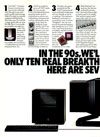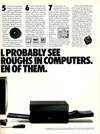
|

|
| (Ad images from a gallery of Apple and NeXT ads at macmothership.com) | |
I first encountered NeXT machines when I was an undergrad and the chair of Vassar's CS department was on NeXT's academic advisory committee and NextStep was at version 0.8 (and before its subsequent case changes to NeXTStep or NeXTSTEP). Around 1989 or 1990 NeXT started promoting their computers with the ads above. They proclaimed "In The 90s, We'll Probably See Only Ten Real Breakthroughs In Computers. Here Are Seven Of Them." Now that about 15 years have passed, how did they do with their prognostication?
- Read/Write/Eraseable Optical Storage
Absolutely right. While NeXT's own optical drive was slow and the disks were expensive, every computer shipped these days has a CD burner built into it. If NeXT's marketing people got anything wrong is was guessing that this would be commonplace in the 90s. Although drives for reading CDs were prevalent in the 90s, it wasn't until 2001-2002 that CD burners became standard. - "The Power of UNIX usable by Mere Mortals"
Mac OS X certainly demonstrates this, some would argue that Linux is usable by mere mortals and others might argue that Windows XP has enough Unix-like ideas behind it to validate this as well. That's two right answers. - Very Large Scale Integration (VLSI)
"It's a mainframe on two chips." - I must profess ignorance on this one. I simply don't know enough about hardware architecture to be able to score this. - Unified Imaging Model
When I programmed in NextStep, I got to learn how to program PostScript. As a stack-based language it expanded the way I think about programming. That's nice from a personal growth aspect, but the real win here was the ability to write one chunk of code that can draw on the screen or printer. OS X has such a unified imaging model, although not based on PostScript. Windows does not. In X11 graphic environments (e.g. most Linux installations) there is no base unified imaging model, but toolkits such as QT provide some abstraction that eases printing.One reason that the unified imaging model isn't a bigger deal is that since 1997 or so, most serious programming efforts have been web based. Thus only those groups creating browsers (i.e. Microsoft, Opera, Mozilla) need to worry much about unity of presentation between the screen and the page.
- Integrated DSP for CD-quality sound
We definitely have CD-quality sound in every computer today. It's hard to remember a time when we didn't. I recall back around 1991 when Sun announced that they would soon distribute software only on CD our office had exactly one drive for reading CDs for 20-30 Sun workstations and that drive cost about $2,000. With the very limited ability for people to put a CD into a computer, few cared about quality sound.Whether or not modern desktop computers have a separate DSP chip like the NeXT machines did or whether the on-board audio on motherboards today do this differently have made this a moot point. Again, I'll avoid answering the question due to my lack of knowledge on hardware architecture.
- Multimedia Email
Again I try to remember; was there was really a time when we couldn't format email with ugly fonts or attach photos easily? Of course NeXT was right with this one. What's more significant about this prediction is that it was made well before the rise of the world wide web1 and the use of the Internet by the general population. - Programmer productivity gains through NextStep
This is another question that has been made different significance due to the growth of the internet. Part of NextStep's appeal was the Interface Builder tool for creating GUI applications. With web server based applications, that's less exciting for most programming.2Another part of NextStep was its well rounded set of class libraries that enabled programmers to get work done without continually recreating the same base code structures. This is available in all major programming environments today including Java, MSFC, Apple Cocoa (descendent of NextStep), Python, etc.
That kind of score begs the question, "Was this all just the output of a marketing department making some easy sure-win predictions?" I think the answer is no. I've already mentioned that the email prediction (#6) was made in the pre-WWW world. The predictions about unified imaging (#4) and programmer productivity (#7) are more esoteric than most marketing departments would care to address, even for a target market more saavy than the general public. The wish for Unix-like stability (#2) in a Windows 3.0/BSoD world was an easy potshot. The predictions on optical storage (#1) and CD-quality sound (#5) were both evolutionary predictions based on floppy drives and existing sound capabilities. These aren't revolutionary predictions, but the NeXT computers were significantly ahead of the competition on these.
Finally, the ad stated that there would be "only ten real breakthroughs" in the 90s. If we accept that these are seven of them, what are the rest? Off the top of my head: the world wide web (1993) (although not strictly speaking a breakthrough in computers, but rather in how they work together), LCD and other techologies which improved laptops, USB (1995), wireless networking (really took off after 2000, but introduced in the 90s).
1 It's worth noting here that the hypertext transfer protocol (HTTP), the first web server and the first web browser were all created by Tim Berners-Lee on a NeXT machine.
2 The first web browser was created using NextStep. Is it too outrageous to suggest that if it weren't for the ease of developing in NextStep, the creation of the world wide web would've been delayed? Tim Berners-Lee suggests that this is the case.
Doug Harris - Cognitive Overflow